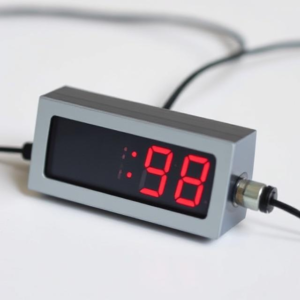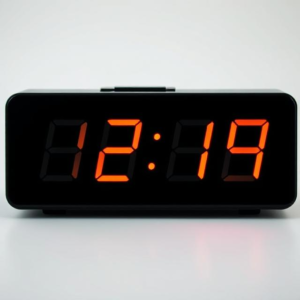What Are Digital Clocks?
A digital clock is an electronic device that displays the time using numerical digits instead of the traditional analog clock hands. The time is typically shown as hours, minutes, and seconds, and it’s usually displayed on a digital display, like an LED or LCD screen.

How Do Digital Clocks Work?
Digital clocks are built around timekeeping circuits that track the passage of time and convert it into readable numerical values. These circuits use oscillators to create regular, precise time intervals and then count those intervals to display the time.
Key Components of a Digital Clock:
- Oscillator (Quartz Crystal):
- The most common way to keep track of time in a digital clock is using a quartz crystal oscillator. This crystal vibrates at a very precise frequency when electricity is applied to it (usually 32,768 times per second).
- These vibrations provide a stable time base to count seconds.
Why Quartz?
Quartz is used because it has the property of being very stable and precise, meaning it can keep accurate time over long periods. This is why quartz watches and clocks are so common. - Counter Circuit:
- The counter circuit takes the oscillator signal (the vibrations of the quartz crystal) and divides it down to count seconds, minutes, and hours.
- For example, the oscillator may generate 32,768 vibrations per second, and a counter divides that number to count seconds (for a clock with 1-second accuracy).
- Display:
- The digital clock needs a display to show the time. This is usually an LED (light-emitting diode) or an LCD (liquid crystal display). The counter circuits send signals to the display to show the correct time.
- For example, the counter might show “12:34:56” for 12 hours, 34 minutes, and 56 seconds.
- Timekeeping Logic:
- This includes the logic circuits that control how time is calculated. When the counter reaches 60 seconds, it sends a signal to increment the minutes by one, and when the minutes reach 60, it increments the hours. The logic ensures the clock works like a real-world clock.
How Timekeeping Works in a Digital Clock:
- Oscillator Generates Pulses:
- The quartz crystal creates a consistent and very precise signal.
- Frequency Division:
- The counter circuit divides the high-frequency signal from the crystal to produce a 1-second pulse. This is the heartbeat of the clock, and every time it pulses, a second passes.
- Counting Seconds:
- The second counter increases by 1 with every pulse. When it reaches 60 seconds, it resets to 0 and increments the minute counter.
- Counting Minutes and Hours:
- When the minute counter reaches 60, it resets to 0 and increments the hour counter. When the hour counter reaches 24 (or 12, depending on the format), it resets back to 0 or 1, depending on whether the clock is in 24-hour format or 12-hour format.
- Displaying the Time:
- The counter sends the numbers to the display, which lights up the correct digits to show the current time.
Key Types of Timekeeping Circuits:
- Quartz Oscillator:
- The quartz crystal oscillator is the heart of most digital clocks. It vibrates at a precise frequency and is the primary time source in clocks and watches. The precision of quartz oscillators is key to their popularity in digital timekeeping.
- Real-Time Clock (RTC):
- Some clocks use a dedicated Real-Time Clock (RTC) chip. This is an integrated circuit (IC) that combines the quartz oscillator with the logic needed to track time, sometimes including a battery to keep the time running even when the power is off.
Example:
A RTC chip might be used in devices like smartphones or computers to keep track of the time, even when the device is turned off. - Microcontrollers:
- Some digital clocks, especially in more advanced or programmable devices, may use a microcontroller to manage the timekeeping process. The microcontroller is a small computer that controls the oscillator, counter, and display logic all in one chip.
- Time Base:
- The time base is the reference signal that the clock uses to count time, and in most cases, this is provided by the oscillator. The most common time base in consumer digital clocks is the 32,768 Hz quartz crystal, which is divided down to generate a 1-second pulse.
Battery Backup:
- Most digital clocks also have a battery backup (especially in real-time clocks). If the main power goes out, the clock will keep running using the battery, so it doesn’t lose track of time.
Applications of Digital Clocks:
- Watches:
- Digital watches use timekeeping circuits to provide the current time in a numerical format on a small digital display.
- Household Clocks:
- Digital clocks for your nightstand, alarm clocks, or microwave ovens also use these circuits to display the time and set alarms.
- Electronics and Computers:
- Digital clocks are often part of more complex systems, like computers, microcontrollers, and digital devices, to keep track of real-time events.
- Industrial Applications:
- In industrial environments, synchronization of operations is crucial. Digital clocks are used to coordinate timing in manufacturing processes, network systems, and time-sensitive machinery.
Summary:
- A digital clock uses a timekeeping circuit (often with a quartz oscillator) to generate precise time intervals and then counts these intervals to display the time as numbers.
- Quartz crystals are used because they vibrate at a very stable frequency, providing accurate timekeeping.
- The counter divides the signal from the oscillator to keep track of seconds, minutes, and hours, and the display shows this time in a readable format.
- Battery backup is commonly used to ensure the clock keeps time even during power outages.
- Digital clocks are used in everyday devices like watches, microwave ovens, and computers to keep track of time with precision.











